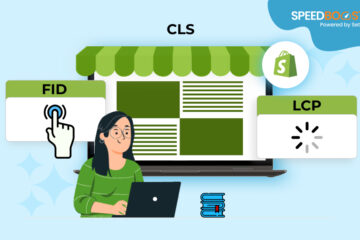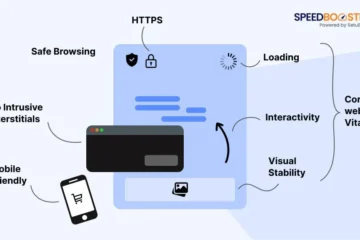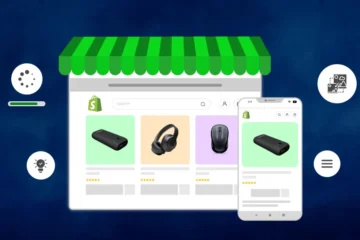Did you know 70% of online shoppers want pages to load in 2 seconds? A 1-second delay can cause a 7% drop in sales. To boost user experience and search rankings, fixing first contentful paint issues in Shopify stores is key. Making your webpage faster is vital, as it boosts user engagement and sales.
What is the First Contentful Paint & Why it’s Important?
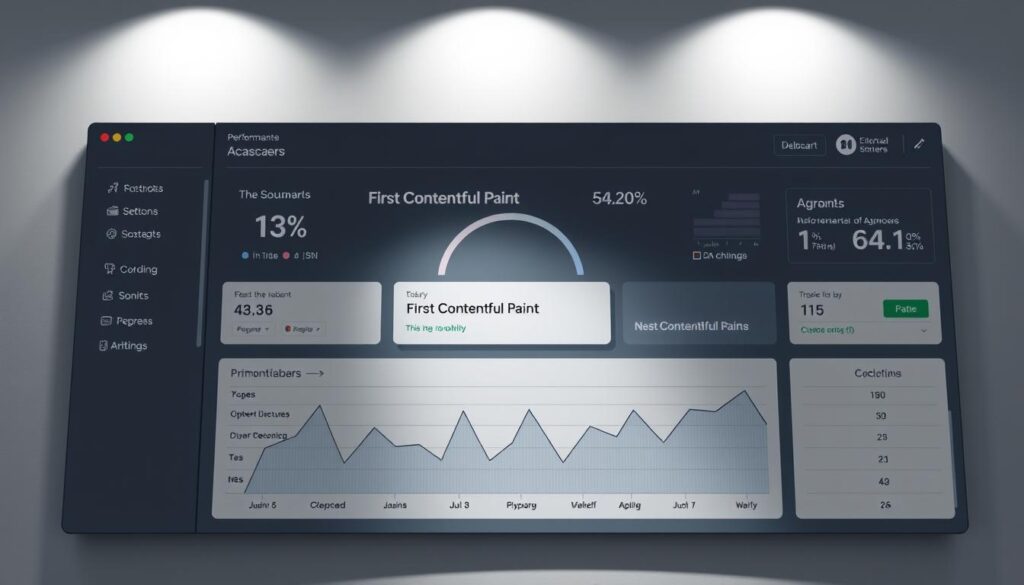
First Contentful Paint (FCP) measures when the first content shows on a webpage. A good FCP score is vital for a better user experience and better search rankings. To get this, you need to speed up your webpage and fix first contentful paint problems. This helps Shopify store owners improve user experience, boost sales, and grow their online presence.
Key Takeaways
Regularly checking and improving web page speed helps Shopify store owners stay competitive and enhance their online presence.
Fixing first contentful paint issues is key for better user experience and search rankings.
Speeding up your webpage can lead to more sales and better user engagement.
A good FCP score is essential for a better user experience and better search rankings.
Shopify store owners can use various tools to analyze and optimize their webpage speed.
Fixing first contentful paint issues requires a detailed approach. This includes optimizing server response time, reducing render-blocking resources, and using critical CSS.
How FCP directly Impacts User Experience
To reduce loading time and enhance website performance, knowing First Contentful Paint (FCP) is key. FCP measures when the first content shows on a webpage. A fast FCP score is vital for a good user experience and better search rankings.
According to Google Pagespeed Insights, anything below 1.8 seconds is a good FCP score while 3 seconds and above is considered poor. FCP contributes to one-tenth of the total Lighthouse Performance Score.
Render-blocking resources can severely affect the FCP. They just disturb the display of content. Using font-display: swap CSS property helps render fallback fonts before anything else, which reduces FCP time.
Focusing on FCP allows websites to minimize web page loading time and consequently improve website performance. Thus, this improves user experience and page ranking for search engines. Using tools such as Google PageSpeed Insights, one can keep track of such improvements.
Common Causes of Poor First Contentful Paint in Shopify
First Contentful Paint is one of the Web Vitals that can be most critical. A slow FCP usually drives the user away quickly, which can hinder sales and also damage organic search rankings.
Among the common issues found in a shopify store are heavy text files, slow servers, and multiple redirects. Optimize website loading: unused CSS should be removed; preload, and lazy load should be performed. You can do smaller CSS and run your JavaScripts faster to help your FCP.
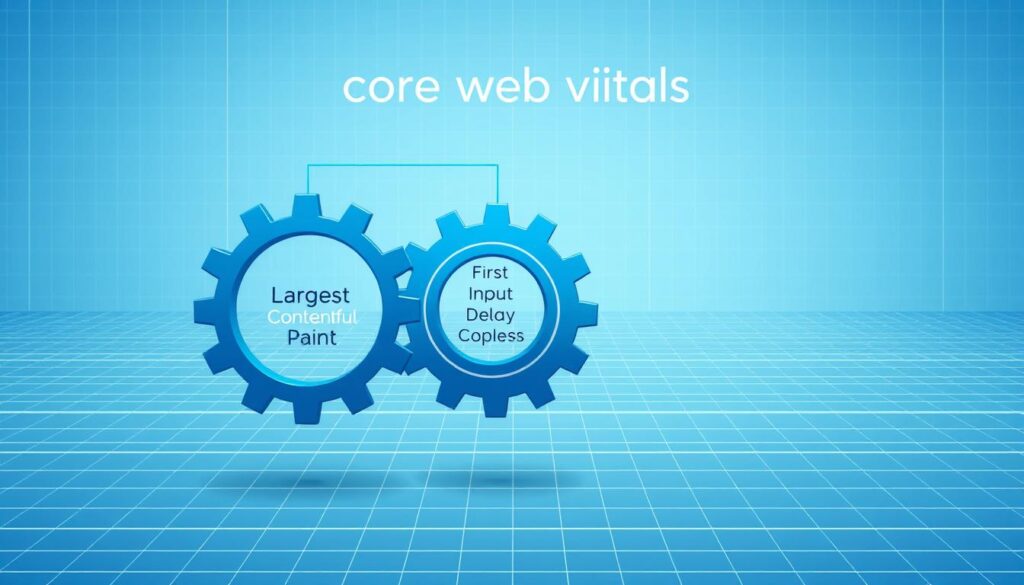
First Contentful Paint (FCP) may be impacted by larger inline DOM sizes, slow Time to First Byte scores, and web font loading options. Consider using Gzip and CDNs, which can definitely improve loading speeds. It would enhance the user experience when responsive.
Google PageSpeed Insights and Lighthouse are some of the tools providing great ideas on how to improve. By tuning in on core web vitals and website optimization in loading, businesses can ultimately help themselves and their sales.
Essential Tools to Measure Your Store’s FCP
FCP refers to First Contentful Paint, and if you want to improve that score within your app, you have to know its current state. Use tools like Google PageSpeed Insights and Chrome DevTools: the information they provide is greatly valuable to your application, not only in indication to optimize First Contentful Paint but overall app performance.
A good FCP score helps tremendously in providing users with an optimized experience and improved search engine rankings. In fact, according to Google, the target loading time for a page to be considered green is 1.8 seconds. Lighthouse Analysis can shed light upon your store’s performance report, portraying its core web vitals in detail.
- FCP score: This measures the time it takes for the first content to appear on the page.
- Largest Contentful Paint (LCP): This measures the time it takes to load the largest above-the-fold content.
- Overall performance score: This provides a complete view of your store’s performance, including FCP, LCP, and other core web vitals.
Thus, by employing these and some other tools while keeping an eye on these metrics, you’ll surely understand how to enhance your store’s FCP, thereby improving user experience and increasing search engine ranks.
How to Fix First Contentful Paint Issues
To allow your Shopify store to load quickly, you have to do much web performance tuning and website speed improvement. The one area that is really key is to make the server respond faster. This greatly enhances the First Contentful Paint (FCP) performance.
Targeting Time to First Byte (TTFB) will ensure your website loads faster, improving the overall experience for users.
Also, seek to minimize the resources that block your website from being fully inflated. Making these resources faster to load will therefore make your site render much more quickly, hence the better experiences for all who visit it.
Also, using critical CSS can make your website’s visuals load faster. This is another way to speed up your website.
- Optimizing server response time to reduce TTFB
- Minimizing render-blocking resources to improve rendering speed
- Implementing critical CSS to enhance visual element loading
By using these strategies, you can make your Shopify store’s FCP better. This will give your customers a better experience when they visit your site.
Optimizing Theme Files for Better Performance
In order to enhance web pages to be faster and to feel better, one of the main focuses should be the theme files. Being able to optimize a theme will aid enormously in bringing down the First Contentful Paint time. Thus, better search engine ranking and user engagement will be the result. Optimization of theme files can lead to a reduction of render-blocking resources, a lowering of server response time, a speeding up of page load, or some combination thereof.
Some important ways to optimize theme files include:
- Minimizing CSS and JavaScript files to reduce file size and improve loading times
- Using efficient coding practices to reduce the complexity of theme files
- Implementing caching mechanisms to reduce the number of requests made to the server
This way, users are allowed to navigate web pages more speedily and cleanly, resulting in willful changes to revenue. One common way to achieve loads of speed-ups is by implementing a content delivery network (CDN), which reduces the loading time by delivering the data from a strategically-located nearest server. Also, image and font optimization will reduce sizes on the server and allow quicker loading, hence better user experience.
An FCP time less than 1.5 seconds is considered good while Google states it should be under 1.8 seconds. With theme file optimizations and other performance tweaks, your page should expect to reach FCP times of between 0.6 and 0.8 seconds domestically and around 1 second internationally. This uplift has a significant effect on user experience and search engine rankings.
Image Optimization Strategies for Faster Loading
An essential part of web page optimization is image optimization. Websites are composed of big chunks of these, and the slow ones can really affect the user experience. They can add to the time it takes to load a web page as well.
The image optimization of an online environment can speed up the load times of websites and, potentially, boost customer satisfaction while decreasing the average time spent on-site.Things such as lazy loading and the use of new image formats are quite beneficial, to say the least, in this process.
Making a large-size image much more compressive and definitely bigger maintains no loss in the resolution. It, therefore, speeds up the loading of websites and uses a bit less bandwidth. Websites will, thus, experience good service to the user by mere emphasis given to image optimization.
- Implementing lazy loading for images below the fold
- Using the “ element to download images earlier
- Setting `fetchpriority=”high”` on LCP images to ensure high-priority loading
- Preloading critical images and fonts to lead to faster loading times
By using these strategies, websites can load faster and feel better to users. This makes for a better online experience.
Advanced JavaScript Optimization Techniques
Optimizing JavaScript files is critical to better FCP and faster page loading. Thus, the minification of JavaScript files reduces the loading data, rendering the page loads faster. Code splitting is a process of breaking down large JavaScript files into smaller chunks that can be loaded only if required.
This method highly improves the core entrance of web vitals like the first contentful paint by lessening the initial load of JavaScript. On top of this, minifying the JavaScript reduces the file size and increases its loading speed. In any case, it is important to always get rid of unused JavaScript to prevent unnecessary loading and speed up the website.
Techniques like lazy loading, which is generally unacceptable for non-core scripts, with proper browser caching of frequent Java Script files. These all enhance your website’s FCP and user experience. Use tools such as Google PageSpeed Insights regularly test for improvement opportunities while keeping core web vitals in mind.
Benefits of these advanced techniques include:
- Improved FCP times
- Enhanced user experience
- Better core web vitals
- Faster website loading optimization
The intention of these methods is actually to work on a website’s optimization and therefore provide better performance, higher user engagement, and an ability to maximize conversions. Always monitor the performance of your website to make sure it continues to deliver satisfactory results and adheres to modern best practices.
Leveraging Shopify’s Built-in Performance Features
Shopify provides many useful functions for your site to enhance its speed and user friendliness. These tools will strengthen your store’s performance and make it easier for customers to use. According to a Google Page Speed Insight study, just one second improvement in speed could lead to an addition of +$8000 in your revenue.
Some of this program’s additional features are content delivery networks, app performance management, and browser caching. In this way, these tools keep load times as low as possible, making your site more optimized. By doing so, these solutions enhance your stores’ core web vitals, thus improving your customers’ experiences.
The possibility of using a CDN, such as Fastly, is great, as it would not only speed things up for your own site but help mobile users as well, who usually have slow connections. By improving the speed and performance of your store, you will get better FCP, improve conversions, and then raise revenue as well.
Conclusion: Achieving and Maintaining Optimal First Contentful Paint
SpeedBoostify offers several strategies to enhance the First Contentful Paint (FCP) metric, which measures the time it takes for the first piece of content to appear on a webpage. Below is a table summarizing the key strategies discussed:
| Strategy | Description |
| Optimize Server Response Time | Improve server response times to reduce Time to First Byte (TTFB), ensuring faster content delivery and enhancing FCP. |
| Minimize Render-Blocking Resources | Reduce or defer the loading of CSS and JavaScript files that block rendering to allow faster display of content. |
| Implement Critical CSS | Extract and inline critical CSS needed for above-the-fold content to render it quickly, deferring non-essential CSS. |
| Optimize Images | Compress and resize images without compromising quality to decrease load times and improve FCP. |
| Utilize Lazy Loading | Defer the loading of non-essential images and videos until they are needed to reduce initial load time. |
| Leverage Browser Caching | Store static resources in the user’s browser cache to decrease load times for repeat visits. |
| Use a Content Delivery Network (CDN) | Distribute content across multiple servers worldwide to ensure faster delivery to users based on their geographic location. |
| Minify CSS and JavaScript Files | Remove unnecessary characters and spaces from CSS and JavaScript files to reduce their size and improve load times. |
| Optimize Web Fonts | Use efficient font formats and consider font-display strategies to ensure text is visible as quickly as possible. |
| Reduce Third-Party Scripts | Limit the use of third-party scripts and plugins that can introduce additional load times and affect FCP. |
To have a good user experience, it is very important to guarantee optimal first contentful paint (FCP). The first contentful paint also works as a boost to the search engine rankings of a Shopify store. You can fix these FCP issues to speed up your webpage by following the strategies in this article.
Watch for the first contentful paint, or FCP, of your store, using Google PageSpeed Insights and Chrome DevTools. Chances are good that simply improving slow server times, render-blocking resources, or image optimizations will give your scores a good boost. Best to aim for an FCP score under 1.8 seconds. These should be fixed because scores over 3 seconds are a danger to user experience.
There are a few easy steps to keep up FCP while boosting your Shopify store. Customers will have a fast and pleasant experience as they shop online because of this. The performance scores of First Contentful Paint in this article will guide the steps needed to fix this issue.
FAQ
What is First Contentful Paint (FCP)?
FCP is one of the biggest web performance metrics that accounts for the time taken for the first bit of content to appear on a page. It is extremely useful because it shows how long it takes many users to start acting with it.
Why is FCP important for Shopify stores?
FCP plays an important role in any Shopify store as it affects customer experience and website search engine ranking. With a high FCP, there is a good user experience resulting in higher sales and better performance on search engines.
How does FCP affect SEO and user experience?
The slow First Contentful Paint affects the SEO and user experience of every Shopify store during its use. As far as Google is concerned, slow page speeds are a big demerit, while slow sites contribute hugely to user frustration. This would often only lead to them leaving the site, which provides lower sales and rankings.
What are the common causes of poor FCP in Shopify stores?
Some of the factors causing first contentful paint to perform poorly may be server slowness, render-blocking resources, or unoptimized files and images. Fix these and your store will work better and load so much faster.
What tools can I use to measure FCP in my Shopify store?
Tools like Google PageSpeed Insights, Chrome DevTools and Lighthouse can measure FCP. They offer insights and tips to improve your store’s performance.
How can I improve FCP in my Shopify store?
To boost FCP, optimize server speed, reduce render-blocking resources, and use critical CSS. Also, optimize theme files and images with lazy loading and next-gen formats.
How can I leverage Shopify’s built-in performance features to improve FCP?
Shopify has features like content delivery networks and app performance management to help FCP. Using these can enhance your store’s speed and performance.


